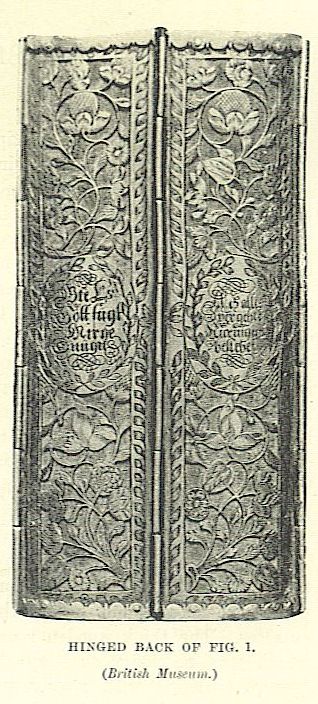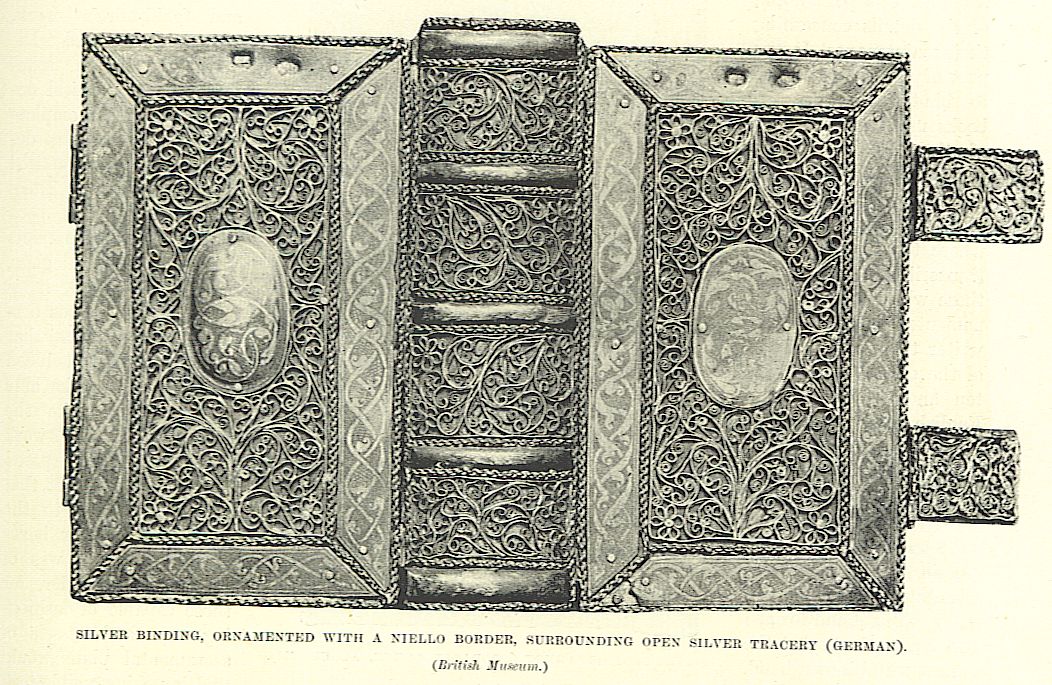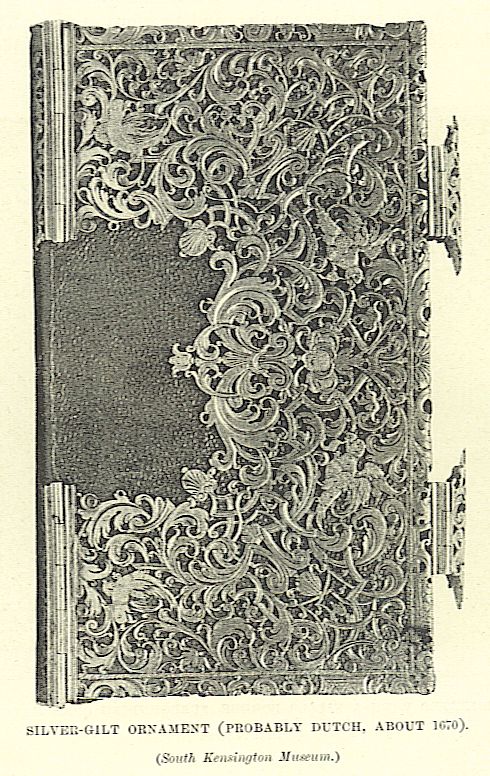The Use of Metal in Bound Books
By S. T. Prideaux
BEFORE the multiplication of books by printing, their covers had more to do with the goldsmith’s art than with that of the binder, whose labours were comparatively restricted.
In those days his functions were merely to fasten together the leaves of the books and place them between two boards, which were then decorated by the workers In precious metals. If skins were used, he covered the boards in leather or parchment; after which they passed into other hands for the fixing of metal clasps and hooks to keep the boards shut, and in most cases nails were also inserted, the round and projecting heads of which preserved the flat surface of the binding.
The high price of manuscripts throughout the Middle Ages, due to the scarcity of parchment, and the time and labour necessary for transcription, explains the luxury of ornament that decorated their outsides. The thick wooden boards -the weight of which was necessary to keep the parchment flat- were enriched with ivories, precious stones, engraved gems, plaques of gold and silver both engraved and filigreed, and the finest enamels. As the books were not often transported from place to place, indeed but little moved, the weight of their covers was not a matter of importance, and these were sometimes made to contain relics of the saints. To all such work the name Byzantine has been applied, probably from the fact that Byzantine art flourished and predominated over that of other countries from the fifth to the twelfth centuries. It has no meaning thus employed as a geographical expression, but is a general term applied to bindings composed of these arts of the gold and silversmith, of the enameller and ivory-carver, executed in the first thirteen centuries of the Christian era, and influenced in spirit by the art of the lower empire.

Of these bindings those enriched with sculptured ivory diptychs on the sides are perhaps the earliest. These were already in use in the time’ of the Komans, the name being derived from StWt/^a, the two wings or boards of the pugillaria. These pugillaria, or table-books, consisted of from two to eight leaves of ivory, wood, or metal, wax-covered to take the impression of the stylus. Their preservation naturally suggested a cover, which was made of ebony or boxwood connected by two or more hinges. The pugillaria were more for private memoranda. The diptychs were larger, and contained public acts of consuls or magistrates inscribed on their wax-covered leaves.

The curious in this matter can consult a learned work of Gori on this subject, published at Florence in 1759, and entitled ” Thesaurus Veterum diptychorum Consulariimi et Ecclesiasticorum,” a work in three folio volumes, describing these diptychs and their embellishment; with sculptured ivories,; plates of silver and gold riveted to the wood and finished in delicate workmanship. In the early days of the Church there were carved illustrations of Scriptural subjects, generally in compartments containing the Saviour and the Apostles, and, indeed, carved especially in harmony with the contents of the manuscript, but occasionally the plaques used were relics of pagan days, and then their subjects were naively interpreted in a Christian sense to suit the use made of them. Such a one, for example, is the famous ” Messe des Fous,” with a musical notation of the twelfth century, now in the library at Sens. The ceremonies that accompanied this office de la Circoncision, and which were tolerated for a considerable time, were often of a most grotesque and ; unsuitable kind -hence its name. The ivories of this manuscript represent the triumph of Bacchus, and date probably as far back as the fourth century. It is well reproduced, together with other ivories, in Labarte’s book, Labarte making almost a specialty of depicting this form of book-cover as Libri did of the enamelled ones.
Of the three classes into which these very early bindings most naturally fall, ivories, goldsmith’s work proper, and enamels, the gold and silver work -pierced, chased, or engraved, and often ornamented besides with precious stones.occupies the middle place, enamelled covers apparently originating when gems became rare.

Throughout all ancient historical records mention is made of this second class of bindings, wrought by command for the wealthy to dedicate to the Church, or by the monks themselves as cases worthy of the devotional works which they enclosed, and often placed in homage on the high altar itself. The number that has come down to our times is very small, nor is it surprising that they should not have escaped the plunder that took place during the different vicissitudes of the Church.
Those extant are scattered over various museums and libraries of Europe, and it is unfortunately very rare to find any previous to the twelfth century on the manuscripts for which they were originally designed. Torn from what they once covered on account of their worth, they have either been recaptured and applied to others of later date; or the book itself ceasing to be of value, they have been removed and kept as works of art on account of their beauty or historic interest. From time to time those so preserved have been facsimiled in such books as Labarte’s ” Histoire des Arts Industriels,” Lacroix’s “Moyen Age et la Renaissance,” and Libri’s “Monuments inedits.” M. Libri, it is well known, possessed a larger number of these valuable covers than almost any other collector, and in his book they are reproduced according to their original size and in their original colours.
This form of costly protection to the not less costly MSS. had itself in turn to be protected, and thus these books were often enclosed in boxes which were themselves sometimes the work of the goldsmith, or else in the outer covers of chevrotin, a thin leather or sendal, a rough silk, These coverings were termed in later times chemises, and sometimes chemises a queue, when there was a margin of stuff which, when reading, folded up on to the page and so allowed a hold on the parchment without the risk of soiling it with the fingers. These chemises appear in inventories and catalogues of libraries of the fourteenth and fifteenth centuries. They are very rarely met with, but one of red sendal may be seen in the Louvre enveloping a Book of Hours of St. Louis, and a later modification of red velvet preserves a large folio in the MSS. Department of the British Museum the original book of indentures made between King Henry VII. and John Islippe, Abbot of Westminster, for the foundation of the King’s Chantry, dated the 16th of July in the nineteenth year of his reign (1500). The boards of this book are covered in red damask cut at the top in a wave pattern. The velvet cover lined with damask is loose on the silk-covered boards, except for an attachment here and there where the bosses and clasps of silver-gilt enamelled are affixed to them. It is cut much larger than the book at the head and tail, and is also brought round over the fore-edge, the clasps lying on the side. Attached by silken cords are five impressions of the King’s Great Seal, each contained in a silver box adorned with the royal badges. This book is in the Harleian collection, to which it was presented by Sir Thomas Hoby, of Bisham in the county of Berks, and is altogether very interesting, though the workmanship is more curious than beautiful. A contemporary duplicate copy of the inside was made for use by the same hand.

The third class of costly bindings of the Middle Ages are the Limoges enamelled covers – style often employed alone, or else in conjunction with gold and precious stones. These are more fitly studied as enamels than as bindings. They are divided into two classes: the kind known as partitioned or champleve, which is the oldest and dates back to the twelfth century, or perhaps even to the early times of Byzantine art; and the painted, enamels, which did not commence before the second half of the fifteenth century. It is the older style to which M. Libri devotes eleven plates with not unnatural pride, as they are of extreme rarity. The Cluny Museum possesses two splendid plaques which once adorned a book : one of them represents the Adoration of the Magi, the other, Etienne de Muret, founder of the Order of Grandmont, talking with St. Nicolas, and the inscription fixes the date, “+ Nicolas Ert parla a mone Teve de Muret.”
Milan Cathedral has a still older and finer specimen in a book-cover presented, it is said, by the Archbishop Aribert to this church in 1020. It is described in ” Les Arts au Moyen Age,” by Du Sommerard, As the monasteries were the depositories of the arts and sciences until the invention of printing, so there were monks whose special avocation it was to bind the manuscripts which others of their fraternity had written and embellished. Warton, in his ” History of English Poetry,” gives an interesting account of the scarcity of books at this period, and of the details concerning their maintenance. It was part of the sacrist’s duty to bind and clasp the books used in the service of the church, and for this purpose a room called the Scriptorium was set apart in every great abbey where those worked who transcribed, as well as those who bound and ornamented. The same writer tells us how some of the classics were written and bound in the English monasteries, and mentions one Henry, a Benedictine monk, of Hyde Abbey near Winchester, who in the year 1178 transcribed Terence, Boetins, Suetonius, and Claudius, which he bound in one volume, and formed the brazen bosses of the covers, with his own hand.

Ecclesiastical histories show that estates were often granted for the support of the Scriptorium, and that special grants were not unfrequently made for purposes connected with the actual binding of books. Thus Charlemagne, about 790, gave an unlimited right of hunting to the monks of Sithin for making their gloves and girdles of the skins of deer, and covers for their books. Nigel gave the monks of Ely two churches in 1160 “ad libros faeiendos;” and the constitutions of the several monasteries enjoined care in the binder’s craft, as well as in the preservation of the libraries. Monks alone, like princes, had the right of practising many arts; they could be writers, illuminators, binders, and goldsmiths, instead of their functions being limited to the performance of one single craft, or even part of a craft, as was statutory in the trade guilds outside the Curch and the Trone.
So it came about that up to the discovery of printing, the multiplication of books and their decoration remained entirely in the hands of monasteries, and until the middle of the fourteenth century religious art prevailed over any form of secular art. The monk Theophile, of whom nothing personal is known, wrote about the middle of the eleventh century a treatise of the utmost importance on the arts of painting or calligraphy, glass – staining, and goldsmith’s work. This work, entitled ” Diversarum artium scheclula,” gives technical descriptions of so complete a kind that the arts described could be practised from them, and as Theophile himself was both a painter of manuscripts and a worker in glass, gold, and enamel, it is probable that it was destined for monks, and that convents always included one or more monks able to repair or make the necessary goldsmith’s work for ecclesiastical purposes. Thus it was, no doubt, that the skill applied to the jewelled covers or boxes for their missals was of such a high order, for those capable of fashioning cups and vessels of sacramental plate would find it no impossible task to beat out the plates of gold or silver for the adornment of their devotional books.
It was not till the fourteenth century that the secular branch of goldsmith’s work had a position apart. Up that time the making of shrines, reliquaries and cups was their chief occupation. During the following century they widened their sphere of labour by manufacturing gold and silver plate, and enriching the treasury and even the wardrobes of kings and nobles. With the sixteenth and seventeenth centuries workmanship superseded the weight of the precious metals. The goldsmith of that time had to be sculptor, modeller, smelter, enameller, jewel-mounter, and metal-worker combined, and hence there is more unity about the metal-wrought bindings of that time than there is about the earlier ones. Indeed, an important point to be observed in connection with the Byzantine covers is, that they have not the unity that belongs to a single work of art. Portions of them made by different artists at different periods, and even in different countries, were incorporated in one cover, or smaller ones were subsequently adapted to larger volumes by resetting them in borders and so enlarging their capabilities. It is, perhaps, partly due to this feature that the term Byzantine has been applied to this mixed work, not wholly so much to express its connection with , a particular country or period, but rather to indicate a certain type, the characteristic of which is this admixture of materials often somewhat incongruous and rarely the work of a single hand, and which followed therein the example set by much of the art of Byzantium itself.
It is with the later ornamented covers that we are engaged at present ; no one would think of imitating the monks in their costly bindings, fit only to adorn a manuscript not less costly than the precious metals themselves. The time has gone by for this application of the goldsmith’s craft, but in the desire to restore binding to the rank of a fine art, I may well trace its history through all phases and see whether there is not something that may be turned to use in each of them. The covers made entirely of metal, pierced, beaten, and engraved, are not perhaps very suitable for revival -at all events, not nearly so much so as the lighter metal ornamentation, which I shall deal with later on. But an occasional use of them can be imagined as being very appropriate, and the examples given here reproduce some of the most attractive as a stimulus to experiment in that direction.
The first is from the British Museum.a German binding of the seventeenth century in gilt metal, pierced and engraved. The back of the cover is treated in the same way, in two longitudinal compartments hinged together to allow of the better opening of the volume, which is somewhat thick. The edges of the leaves are painted and gauffered, the head and tail being protected at the back by a flat metal cap also pierced and chased, forming part of the cover. The whole is the most beautiful example of a metal binding. It contains a ” Frauenzimmer Spiegel,” or series of female characters taken from the Old and the New Testament, by Hieron Orteln, with forty engravings.
The next is also a German binding of silver, ornamented with a niello border surrounding open silver tracery. It contains “Flosculi Historiarum,” by Jean de Bussieris, dated 1688, but the cover is older than the book. It is also in the British Museum.
The third is a cover of Arabesque open work in silver-gilt, probably Dutch work about 1670., in the South Kensington Museum. It is a good example of a mode of treating book covers not often resorted to, but very effective, in which the ornamentation is concentrated on the front instead of the back portion of the book ; and which is as suitable for flat tooling as for pierced work. The last illustration is that of a very delicate piece of work containing Gobel’s ” Jesum Liebender Seelen Tagliche Himilreis,” published at Nuremberg in 1704, and now in the South Kensington Museum. It is in a contemporary binding of oak boards covered with perforated silver-work, and has similar silver clasps. Both the piercing and chasing as well as the design are in the most perfect taste.
